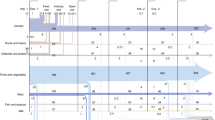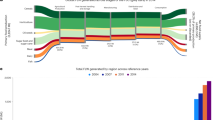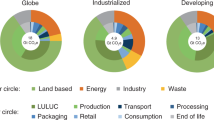Abstract
Global greenhouse gas (GHG) emissions from food loss and waste (FLW) are not well characterized from cradle to grave. Here GHG emissions due to FLW in supply chain and waste management systems are quantified, followed by an assessment of the GHG emission reductions that could be achieved by policy and technological interventions. Global FLW emitted 9.3 Gt of CO2 equivalent from the supply chain and waste management systems in 2017, which accounted for about half of the global annual GHG emissions from the whole food system. The sources of FLW emissions are widely distributed across nine post-farming stages and vary according to country, region and food category. Income level, technology availability and prevailing dietary pattern also affect the country and regional FLW emissions. Halving FLW generation, halving meat consumption and enhancing FLW management technologies are the strategies we assess for FLW emission reductions. The region-specific and food-category-specific outcomes and the trade-off in emission reductions between supply chain and waste management are elucidated. These insights may help decision makers localize and optimize intervention strategies for sustainable FLW management.
This is a preview of subscription content, access via your institution
Access options
Access Nature and 54 other Nature Portfolio journals
Get Nature+, our best-value online-access subscription
$29.99 / 30 days
cancel any time
Subscribe to this journal
Receive 12 digital issues and online access to articles
$119.00 per year
only $9.92 per issue
Buy this article
- Purchase on Springer Link
- Instant access to full article PDF
Prices may be subject to local taxes which are calculated during checkout



Similar content being viewed by others
Data availability
The data that support the findings of this study are available in the Supplementary Information and Source Data. Most of the datasets used in the analysis are available publicly, such as from FAOSTAT or the World Bank. The raw data on the food supply are available on the FAOSTAT website and can be accessed at https://www.fao.org/faostat/en/#home. The raw data on FLW are available on the FAOSTAT website and can be accessed at https://www.fao.org/platform-food-loss-waste/flw-data/en/. All other data are available from the corresponding authors upon reasonable request. Source data are provided with this paper.
Code availability
The statistical coding is available from the corresponding authors on reasonable request.
References
Crippa, M. et al. Food systems are responsible for a third of global anthropogenic GHG emissions. Nat. Food 2, 198–209 (2021).
Xue, L. et al. Missing food, missing data? A critical review of global food losses and food waste data. Environ. Sci. Technol. 51, 6618–6633 (2017).
Roodhuyzen, D. M. A., Luning, P. A., Fogliano, V. & Steenbekkers, L. P. A. Putting together the puzzle of consumer food waste: towards an integral perspective. Trends Food Sci. Technol. 68, 37–50 (2017).
Bernstad Saraiva Schott, A. & Andersson, T. Food waste minimization from a life-cycle perspective. J. Environ. Manage. 147, 219–226 (2015).
Tong, H. et al. A comparative life cycle assessment on four waste-to-energy scenarios for food waste generated in eateries. Appl. Energy 225, 1143–1157 (2018).
Gustafsson, J., Cederberg, C., Sonesson, U. & Emanuelsson, A. The methodology of the FAO study: "Global Food Losses and Food Waste-extent, causes and prevention"-FAO, 2011. (SIK Institutet för livsmedel och bioteknik, 2013).
Yokokawa, N., Kikuchi-Uehara, E., Amasawa, E., Sugiyama, H. & Hirao, M. Environmental analysis of packaging-derived changes in food production and consumer behavior. J. Ind. Ecol. 23, 1253–1263 (2019).
Scherhaufer, S., Moates, G., Hartikainen, H., Waldron, K. & Obersteiner, G. Environmental impacts of food waste in Europe. Waste Manage. 77, 98–113 (2018).
Hodge, K. L., Levis, J. W., DeCarolis, J. F. & Barlaz, M. A. Systematic evaluation of industrial, commercial, and institutional food waste management strategies in the United States. Environ. Sci. Technol. 50, 8444–8452 (2016).
Slorach, P. C., Jeswani, H. K., Cuéllar-Franca, R. & Azapagic, A. Environmental sustainability of anaerobic digestion of household food waste. J. Environ. Manage. 236, 798–814 (2019).
Corrado, S. & Sala, S. Food waste accounting along global and European food supply chains: state of the art and outlook. Waste Manage. 79, 120–131 (2018).
Liu, J., Lundqvist, J., Weinberg, J. & Gustafsson, J. Food losses and waste in China and their implication for water and land. Environ. Sci. Technol. 47, 10137–10144 (2013).
Springmann, M. et al. Options for keeping the food system within environmental limits. Nature 562, 519–525 (2018).
Lipinski, B. SDG Target 12.3 on Food Loss and Waste: 2020 Progress Report (World Resources Institute, 2020).
Le Quéré, C. et al. Temporary reduction in daily global CO2 emissions during the COVID-19 forced confinement. Nat. Clim. Change 10, 647–653 (2020).
Xu, X. et al. Global greenhouse gas emissions from animal-based foods are twice those of plant-based foods. Nat. Food 2, 724–732 (2021).
Food Wastage Footprint Impacts on Natural Resources (FAO, 2013).
Poore, J. & Nemecek, T. Reducing food’s environmental impacts through producers and consumers. Science 360, 987–992 (2018).
Abdel-Basset, M., Manogaran, G. & Mohamed, M. Internet of Things (IoT) and its impact on supply chain: a framework for building smart, secure and efficient systems. Future Gener. Comput. Syst. 86, 614–628 (2018).
Misra, N. N. et al. IoT, big data and artificial intelligence in agriculture and food industry. IEEE Internet Things J. https://doi.org/10.1109/JIOT.2020.2998584 (2020).
Zavala-Alcívar, A., Verdecho, M.-J. & Alfaro-Saiz, J.-J. Assessing and selecting sustainable and resilient suppliers in agri-food supply chains using artificial intelligence: a short review. In Camarinha-Matos, L.M., Afsarmanesh, H., Ortiz, A. (eds) Boosting Collaborative Networks 4.0. PRO-VE 2020. IFIP Advances in Information and Communication Technology, vol 598. 501–510 (Springer 2020).
Alfian, G. et al. Improving efficiency of RFID-based traceability system for perishable food by utilizing IoT sensors and machine learning model. Food Control 110, 107016 (2020).
Wang, Y., Levis, J. W. & Barlaz, M. A. An assessment of the dynamic global warming impact associated with long-term emissions from landfills. Environ. Sci. Technol. 54, 1304–1313 (2020).
Davison, T. M., Black, J. L. & Moss, J. F. Red meat—an essential partner to reduce global greenhouse gas emissions. Anim. Front. 10, 14–21 (2020).
Nordahl, S. L. et al. Life-cycle greenhouse gas emissions and human health trade-offs of organic waste management strategies. Environ. Sci. Technol. 54, 9200–9209 (2020).
Neugebauer, M. & Sołowiej, P. The use of green waste to overcome the difficulty in small-scale composting of organic household waste. J. Clean. Prod. 156, 865–875 (2017).
Bennetzen, E. H., Smith, P. & Porter, J. R. Decoupling of greenhouse gas emissions from global agricultural production: 1970–2050. Glob. Change Biol. 22, 763–781 (2016).
Davis, K. F., Downs, S. & Gephart, J. A. Towards food supply chain resilience to environmental shocks. Nat. Food 2, 54–65 (2021).
Grunert, K. G., Hieke, S. & Wills, J. Sustainability labels on food products: consumer motivation, understanding and use. Food Policy 44, 177–189 (2014).
Mok, W. K., Tan, Y. X. & Chen, W. N. Technology innovations for food security in Singapore: a case study of future food systems for an increasingly natural resource-scarce world. Trends Food Sci. Technol. 102, 155–168 (2020).
Hanning, I. B., O’Bryan, C. A., Crandall, P. G. & Ricke, S. C. Food safety and food security. Nat. Educ. Knowl. 3, 9 (2012).
WBG (World Bank Group, 2020).
Nakicenovic, N. et al. Special Report on Emissions Scenarios (IPCC, Cambridge Univ. Press, 2000).
Li, M. et al. Global food-miles account for nearly 20% of total food-systems emissions. Nat. Food 3, 445–453 (2022).
Mc Carthy, U. et al. Global food security—issues, challenges and technological solutions. Trends Food Sci. Technol. 77, 11–20 (2018).
D’Odorico, P., Carr, J. A., Laio, F., Ridolfi, L. & Vandoni, S. Feeding humanity through global food trade. Earth’s Future 2, 458–469 (2014).
Tichenor, N. E., Peters, C. J., Norris, G. A., Thoma, G. & Griffin, T. S. Life cycle environmental consequences of grass-fed and dairy beef production systems in the northeastern United States. J. Clean. Prod. 142, 1619–1628 (2017).
Forouhi, N. G. & Unwin, N. Global diet and health: old questions, fresh evidence, and new horizons. Lancet 393, 1916–1918 (2019).
Springmann, M. et al. Mitigation potential and global health impacts from emissions pricing of food commodities. Nat. Clim. Change 7, 69–74 (2017).
Foong, A., Pradhan, P., Frör, O. & Kropp, J. P. Adjusting agricultural emissions for trade matters for climate change mitigation. Nat. Commun. 13, 3024 (2022).
Pradhan, P. et al. Urban food systems: how regionalization can contribute to climate change mitigation. Environ. Sci. Technol. 54, 10551–10560 (2020).
FAOSTAT (Food and Agriculture Organization of the United Nations, 2020).
UN M49 (United Nations Statistics Division, 1999).
Xue, L. et al. China’s food loss and waste embodies increasing environmental impacts. Nat. Food 2, 519–528 (2021).
Food Loss and Waste Database (FAO, 2022); https://www.fao.org/platform-food-loss-waste/flw-data/en/
Zhang, H. & Matsuto, T. Mass and element balance in food waste composting facilities. Waste Manage. 30, 1477–1485 (2010).
Kaza, S., Yao, L., Bhada-Tata, P. & Van Woerden, F. What a Waste 2.0: A Global Snapshot of Solid Waste Management to 2050 (World Bank, 2018).
Acknowledgements
We thank the Jiangsu Special Project for Introducing Foreign Talents (grant no. BX2019015, K.Y.) and the Key Achievement Cultivation Plan Project of Nanjing Forestry University (K.Y.) for financial support.
Author information
Authors and Affiliations
Contributions
All authors provided content and reviewed, edited and approved this manuscript. J.Z., Z.L. and T.S. devised the methodology, collected and analysed the data, characterized the materials, wrote the Supplementary Information and reviewed and edited the manuscript. W.L. collected and analysed the data and reviewed and edited the manuscript. W.Z. collected and analysed the data. X.W. reviewed and edited the manuscript. X.F. devised the methodology, structuring and reviewed and edited the manuscript. H.T. conceptualized the project, devised the methodology and reviewed and edited the manuscript. K.Y. conceptualized the project, devised the methodology, wrote the manuscript and the Supplementary Information and reviewed and edited the manuscript.
Corresponding authors
Ethics declarations
Competing interests
The authors declare no competing interests.
Peer review
Peer review information
Nature Food thanks the anonymous reviewers for their contribution to the peer review of this work.
Additional information
Publisher’s note Springer Nature remains neutral with regard to jurisdictional claims in published maps and institutional affiliations.
Supplementary information
Supplementary Information
Supplementary Figs. 1–13, Tables 1–8 and Discussion.
Source data
Source Data Fig. 1
Source data for Fig. 1.
Source Data Fig. 2
Source data for Fig. 2.
Source Data Fig. 3
Source data for Fig. 3.
Rights and permissions
Springer Nature or its licensor (e.g. a society or other partner) holds exclusive rights to this article under a publishing agreement with the author(s) or other rightsholder(s); author self-archiving of the accepted manuscript version of this article is solely governed by the terms of such publishing agreement and applicable law.
About this article
Cite this article
Zhu, J., Luo, Z., Sun, T. et al. Cradle-to-grave emissions from food loss and waste represent half of total greenhouse gas emissions from food systems. Nat Food 4, 247–256 (2023). https://doi.org/10.1038/s43016-023-00710-3
Received:
Accepted:
Published:
Issue Date:
DOI: https://doi.org/10.1038/s43016-023-00710-3
This article is cited by
-
Methane emissions from landfills differentially underestimated worldwide
Nature Sustainability (2024)
-
Closing the gap between climate regulation and food security with nano iron oxides
Nature Sustainability (2024)
-
The food–climate nexus
Nature Food (2023)
-
Eat less meat: will the first global climate deal on food work?
Nature (2023)
-
Saving food mitigates climate change
Nature Food (2023)



